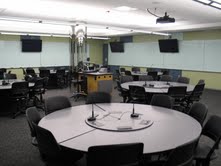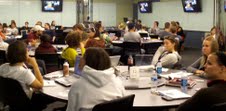Key Takeaways
- Teaching in high-tech learning environments that center on collaboration and team-based learning often requires a complete course redesign and great deal of faculty time.
- One solution for helping faculty centers on critical reflection during the course, including finding support resources, recommending tools or technologies, adhering to a plan, and focusing on change in small increments.
- Critical reflection is immediately useful, flexible, and cost-effective, with the benefits of reengaging faculty members in their content and their teaching, maximizing the affordance of the learning environment, and enhancing the overall learning experience.
Teaching in new high-tech, collaborative learning environments often involves a complete course redesign — a time-consuming effort that can become overwhelming amid the other responsibilities faced by faculty members.1 Consequently, instead of innovating and transforming instructional activities in accordance with the affordances of these learning environments, even the most excited and experienced early adopters may find themselves reverting to old lecture notes and uninspiring PowerPoint slides. Without careful consideration, teaching in high-tech learning environments can prove far less inspiring and effective than originally anticipated.
Figure 1 shows one of the University of Minnesota's Active Learning Classrooms (ALCs), which feature a number of affordances. These affordances include large circular tables seating nine students, document cameras, 360-degree glass markerboards, and large LCD screens at each table that allow students to toggle among up to three laptop computers to facilitate student-generated collaborative work.

Figure 1. University of Minnesota Active Learning Classroom
Whereas the research tells us that one of the most important components of teaching involves regularly taking a step back and honestly reassessing the teaching and learning situation,2 very few faculty members allow themselves to take the time for pedagogical reflection. However, this type of critical reflection is imperative when teaching in new, high-tech learning environments that may introduce unfamiliar pedagogical paradigms.
Critical Reflection Through Living Educational Theory
One solution for the challenges involved in teaching in new, high-tech learning environments is critical reflection through the Living Educational Theory approach.3 This approach consists of a subdivision of Action Research whereby educators examine the "educational influences in their own learning" as they actively engage in a "lived" reflection on the teaching and learning situation.4
Specifically, we suggest that IT experts can support faculty members by following these steps:
- First, make the available support resources such as hardware and software, as well as consultation and productions services, at the departmental-, collegiate-, and university-levels, transparent for faculty members. Services could include instructional design, software training, professional development funds, best practices, and just-in-time pedagogical and tool-based training. If possible, offer to partner with them to help maximize the teaching and learning experience in a higher-tech learning space.
- Then, decide what tools or technologies to recommend — depending on the instructor's willingness and technical aptitude as well as the resources available. Options include, but are not limited to, audio recorders, video recorders, blogs, or even pen and paper.
- Next, urge your faculty members to develop a plan, put it in writing, and stick to it. The plan should include specific reflection questions and dates/times/location for the reflection at regular intervals. A plan could be to reflect once a week, perhaps after each class period, before the class period, or whenever is feasible for the faculty member. Help them develop thought-provoking, reflective questions and find specific dates and times within their busy schedules for each reflection.
- Finally, offer to review their reflections with them and suggest implementing iterative changes in small increments. Avoid making too many suggestions at one time. For example, you might suggest partnering to revise one troublesome subunit or lesson for the next iteration of the course. Or, if you notice the reflections contain questions about the use of a particular technology, such as video, you might suggest a new software program to provide the just-in-time support needed for the faculty member to succeed.
Example: Video-Based, Reflective Interviewing Strategy
This example features a video-based, reflective interview strategy where the interviewer (Aimee Whiteside) asks the instructor (Amy Garrett Dikkers) to reflect on her teaching and technology integration in the high-tech learning environment. The new learning environment for the course was one of the University of Minnesota's ALCs, where learning typically centers on hands-on activities and problems that require students to interact to reach a solution (see Figure 2). The course, School and Society, consists of a foundation of American education course required of most students for K–12 licensure; it covers the history, politics, sociology, and philosophy of education. These concepts are state-mandated in Minnesota for all teachers, regardless of content area and grade level.

Figure 2. The School and Society Course, Summer 2009
Below are a few clips from weekly interviews scheduled throughout the course:
AW: "What did you learn about your teaching in this learning environment from watching a video recording of your earliest class sessions?"
AGD: Video Response: Maximizing Space and Class Time (1 min, 5 sec)
AW: "Did the technology and other affordances of this learning environment influence your teaching and learning activities? Explain."
AGD: Video Response: Integrating Video to Engage Students in the Course Content (4 min, 12 sec)
AW: "What one word or phrase describes your experience this week teaching in this learning environment?"
AGD: Video Response: Keeping Me More Engaged in my Teaching (1 min, 5 sec)
AW: "What have you learned in the process of redesigning an instructional activity in this learning environment?"
AGD: Video Response: Success in a Team-Based Learning Approach (2 min, 26 sec)
Even though this example features a video-based, reflective interview strategy, it is merely one approach among many to help faculty members who are teaching in high-tech learning environments. With as little as a free software application or even pen and paper, instructors can follow the steps for Living Educational Theory.
Conclusion
Overall, teaching in high-tech, collaborative learning environments requires a great deal of time, thought, innovation, risk, redesign, and support. This process involves difficult decisions that should be carefully considered. Critical reflection through the Living Educational Theory approach can transform the overall learning experience by reengaging instructors in their teaching and by maximizing the affordances of these new high-tech, collaborative learning spaces.
- Tom Warger and Gregory Dobbin, "Learning Environments: Where Space, Technology, and Culture Converge," EDUCAUSE Learning Initiative, October 2009; "21st Century Learning Environments," "(Tucson, AZ: Partnership for 21st Century Skills, 2009).
- Donald A. Schön, The Reflective Practitioner: How Professionals Think in Action (New York: Basic Books, 1983); Donald A. Schön, Educating the Reflective Practitioner: Toward a New Design for Teaching and Learning in the Professions (San Francisco: Jossey-Bass, 1987); Stephen Brookfield, Becoming a Critically Reflective Teacher (San Francisco: Jossey-Bass, 1995); National Research Council Committee on Learning Research and Educational Practice, How People Learn: Brain, Mind, Experience, and School: Expanded Edition (Washington, DC: National Academy Press, 2000); L. Dee Fink, Creating Significant Learning Experiences: An Integrated Approach to Designing College Courses (San Francisco: Jossey-Bass, 2003); and Neville Hatton and David Smith, "Reflection in Teacher Education: Towards Definition and Implementation," Teaching & Teacher Education, vol. 11, no. 1 (January 1995), pp. 33–49.
- Jean McNiff and Jack Whitehead, Action Research Living Theory (London: Sage, 2006); Jack Whitehead, "How Do I Improve My Practice? Creating and Legitimating an Epistemology of Practice," Reflective Practice, vol. 1, no. 1 (2000), pp. 91–104; and Max VanManen, Researching Lived Experience: Human Science for an Action Sensitive Pedagogy (Albany, NY: State University of New York Press, 1999).
- Action Research: "What Is a Living Educational Theory Approach to Action Research and a Human Existence?"
© 2010 Aimee L. Whiteside and Amy Garrett Dikkers. The text of this article is licensed under the Creative Commons Attribution-Noncommercial-No Derivative Works 3.0 license.
